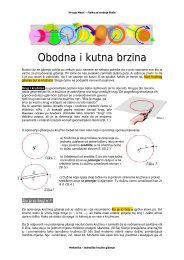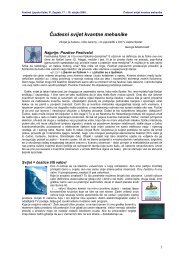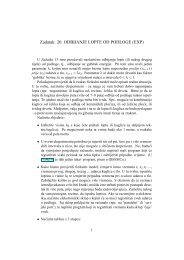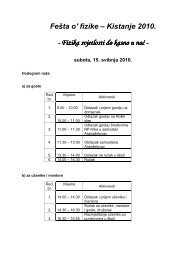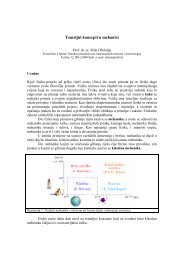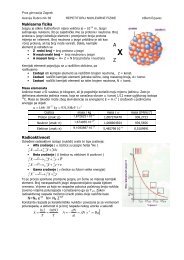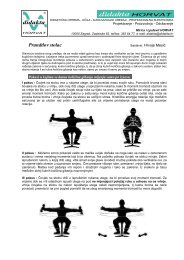Inverted Pendulum
Inverted Pendulum
Inverted Pendulum
Create successful ePaper yourself
Turn your PDF publications into a flip-book with our unique Google optimized e-Paper software.
Problem 10.<br />
<strong>Inverted</strong> <strong>Pendulum</strong>
Problem 10.<br />
It is possible to stabilise an inverted<br />
pendulum. It is even possible to stabilise<br />
inverted multiple pendulum (one pendulum<br />
on the top of the other). Demonstrate the<br />
stabilisation an determine on which<br />
parameters this depends.
Introduction<br />
• <strong>Inverted</strong> pendulum - center of mass is<br />
above its point of suspension<br />
• Achieving stabilisation – pendulum<br />
suspension point vibrating!<br />
• Principal parameters:<br />
• lenght<br />
• frequency<br />
• amplitude
Introduction cont.
Experimental approach<br />
• Apparatus<br />
• Construction<br />
• Measurements:<br />
• <strong>Pendulum</strong> angle in time<br />
• Stabilisation conditions:<br />
amplitude vs. pendulum length<br />
amplitude vs. frequency<br />
• Double pendulum
Apparatus<br />
• Speaker<br />
(subwoofer)<br />
• Function generator<br />
• Amplifier<br />
• Stroboscope<br />
• Pendula (wooden)
Apparatus cont.<br />
• Speaker – low harmonics generation<br />
• Audio range amplifier<br />
• Stroboscope – accurate frequency<br />
measurement<br />
• Point of support amplitude measured with<br />
(šubler)<br />
• Multiple measurements for error<br />
determination
Construction<br />
Lengths [cm]:<br />
4<br />
4.5<br />
5<br />
5.5<br />
6<br />
6.5<br />
7<br />
7.5<br />
Density [kg/m 3 ]:<br />
626
Measurements<br />
• Stability – pendulum returns to upward<br />
orientation<br />
• measurements of boundary conditions:<br />
frequency vs. amplitude<br />
length vs. amplitude<br />
angle in time (two cases);<br />
• inverted pendulum<br />
• “inverted” inverted pendulum –<br />
for drag determination
Double pendulum
Theoretical approach<br />
• <strong>Pendulum</strong> – tends to state of minimal energy<br />
• Upward stabilisation possible if enough energy<br />
is given at the right time<br />
• Formalism – two possibilities:<br />
• equation of motion<br />
• energy equation – Lagrangian formalism<br />
• Forces approach – more intuitive:
Forces on pendulum<br />
l − pendulum lenght<br />
ϕ − angle between<br />
pendulum and y axis<br />
h&<br />
− acceleration of<br />
F<br />
F<br />
r<br />
y<br />
suspension point<br />
− resistance<br />
− inertial force acting<br />
on the center of mass
Equation of motion<br />
• In noninertial pendulum system:<br />
I<br />
s<br />
1<br />
ϕ&= − Fyl<br />
sinϕ<br />
−<br />
2<br />
• Inertial acceleration:<br />
• gravity component<br />
• periodical acceleration of suspension<br />
point<br />
1<br />
2<br />
F l<br />
r<br />
l − pendulum<br />
ϕ − angle<br />
I<br />
s<br />
F<br />
F<br />
r<br />
y<br />
pendulum<br />
− pendulum<br />
inertia<br />
−<br />
resistance<br />
− inertial force acting<br />
on the<br />
lenght<br />
between<br />
and<br />
moment<br />
center of<br />
y axis<br />
of<br />
mass
Equation of motion cont.<br />
• Resistance force – estimated to be linear to<br />
angular velocity<br />
• “inverted” inverted pendulum measurements<br />
30<br />
20<br />
10<br />
eff<br />
−<br />
e 2<br />
ϕ max ~ β<br />
t<br />
angle [°]<br />
0<br />
β<br />
eff<br />
−<br />
damping<br />
coefficien<br />
t<br />
-10<br />
-20<br />
β<br />
ϕ<br />
eff<br />
max<br />
= 3.0 s<br />
-1<br />
− angular<br />
amplitude<br />
-30<br />
-0,5 0,0 0,5 1,0 1,5 2,0 2,5 3,0<br />
time [s]
Equation of motion cont.<br />
⇒ equation of motion:<br />
2<br />
2⎛ Aω<br />
⎞<br />
& ϕ + β & ϕ + ω0 ⎜1<br />
− sin ω<br />
⎟<br />
eff<br />
t sin ϕ =<br />
⎝ g ⎠<br />
0<br />
ω<br />
2<br />
0<br />
− parameter<br />
A − suspension<br />
ω − suspension<br />
:<br />
ω<br />
2<br />
0<br />
point<br />
point<br />
=<br />
3<br />
2<br />
l<br />
g<br />
amplitude<br />
angular<br />
frequency<br />
• Analytical solution very difficult<br />
• Numerical solution – Euler method
Equation of motion cont.<br />
0,6<br />
0,4<br />
angle [rad]<br />
0,2<br />
0,0<br />
l = 5.0 cm<br />
ω = 685 rad/s<br />
2A<br />
= 4.5 mm<br />
-0,2<br />
-0,4<br />
-0,6<br />
0,0 0,2 0,4 0,6 0,8 1,0 1,2 1,4 1,6<br />
time [s]
Stability conditions<br />
⇒From equation of motion solutions stability<br />
determination:<br />
200<br />
180<br />
l<br />
=<br />
5.0<br />
cm<br />
160<br />
frequency [Hz]<br />
140<br />
120<br />
100<br />
80<br />
60<br />
40<br />
0,001 0,002 0,003 0,004 0,005 0,006<br />
2A [m]
Stability conditions cont.<br />
9<br />
8<br />
7<br />
length [cm]<br />
6<br />
5<br />
4<br />
freq<br />
= 100<br />
Hz<br />
3<br />
1,8 2,0 2,2 2,4 2,6 2,8 3,0 3,2 3,4<br />
2A [mm]
Stability conditions cont.<br />
• Agreement between model and measurements<br />
relatively good<br />
• Discrepancies due to:<br />
• errors in small amplitude measurements<br />
• speaker characteristics (higher<br />
harmonics generation)<br />
• nonlinear damping...
Conclusion<br />
• we determined and experimentaly prove<br />
stability parameters<br />
• mass is not a parameter<br />
• theoretical analisis match with results<br />
• we managed to stabilise multiple inverted<br />
pendulum



